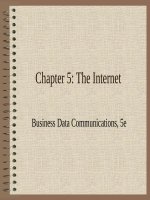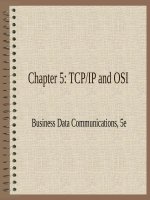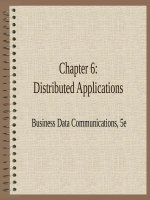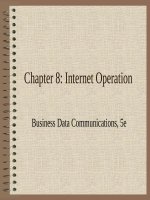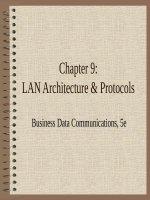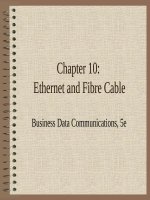Business data communications 4e chapter 7
Bạn đang xem bản rút gọn của tài liệu. Xem và tải ngay bản đầy đủ của tài liệu tại đây (481.99 KB, 33 trang )
Chapter 7:
Transmission Media
Business Data Communications, 4e
Classes of Transmission Media
Conducted or guided media
use a conductor such as a wire or a fiber optic
cable to move the signal from sender to receiver
Wireless or unguided media
use radio waves of different frequencies and do
not need a wire or cable conductor to transmit
signals
Design Factors
for Transmission Media
Bandwidth: All other factors remaining constant, the greater the
band-width of a signal, the higher the data rate that can be
achieved.
Transmission impairments. Limit the distance a signal can
travel.
Interference: Competing signals in overlapping frequency bands
can distort or wipe out a signal.
Number of receivers: Each attachment introduces some
attenuation and distortion, limiting distance and/or data rate.
Electromagnetic Spectrum for
Transmission Media
Guided Transmission Media
Transmission capacity depends on the distance
and on whether the medium is point-to-point or
multipoint
Examples
twisted pair wires
coaxial cables
optical fiber
Twisted Pair Wires
Consists of two insulated copper wires arranged in
a regular spiral pattern to minimize the
electromagnetic interference between adjacent pairs
Often used at customer facilities and also over
distances to carry voice as well as data
communications
Low frequency transmission medium
Types of Twisted Pair
STP (shielded twisted pair)
the pair is wrapped with metallic foil or braid to
insulate the pair from electromagnetic
interference
UTP (unshielded twisted pair)
each wire is insulated with plastic wrap, but the
pair is encased in an outer covering
Ratings of Twisted Pair
Category 3 UTP
data rates of up to 16mbps are achievable
Category 5 UTP
data rates of up to 100mbps are achievable
more tightly twisted than Category 3 cables
more expensive, but better performance
STP
More expensive, harder to work with
Twisted Pair Advantages
Inexpensive and readily available
Flexible and light weight
Easy to work with and install
Twisted Pair Disadvantages
Susceptibility to interference and noise
Attenuation problem
For analog, repeaters needed every 5-6km
For digital, repeaters needed every 2-3km
Relatively low bandwidth (3000Hz)
Coaxial Cable (or Coax)
Used for cable television, LANs, telephony
Has an inner conductor surrounded by a
braided mesh
Both conductors share a common center axial,
hence the term “co-axial”
Coax Layers
outer jacket
(polyethylene)
shield
(braided wire)
insulating material
copper or aluminum
conductor
Coax Advantages
Higher bandwidth
400 to 600Mhz
up to 10,800 voice conversations
Can be tapped easily (pros and cons)
Much less susceptible to interference than
twisted pair
Coax Disadvantages
High attenuation rate makes it expensive over
long distance
Bulky
Fiber Optic Cable
Relatively new transmission medium used by
telephone companies in place of long-distance
trunk lines
Also used by private companies in implementing
local data communications networks
Require a light source with injection laser diode
(ILD) or light-emitting diodes (LED)
Fiber Optic Layers
consists of three concentric sections
plastic jacket
glass or plastic fiber core
cladding
Fiber Optic Types
multimode step-index fiber
the reflective walls of the fiber move the light pulses to the
receiver
multimode graded-index fiber
acts to refract the light toward the center of the fiber by
variations in the density
single mode fiber
the light is guided down the center of an extremely narrow core
Fiber Optic Signals
fiber optic multimode
step-index
fiber optic multimode
graded-index
fiber optic single mode
Fiber Optic Advantages
greater capacity (bandwidth of up to 2 Gbps)
smaller size and lighter weight
lower attenuation
immunity to environmental interference
highly secure due to tap difficulty and lack of
signal radiation
Fiber Optic Disadvantages
expensive over short distance
requires highly skilled installers
adding additional nodes is difficult
Wireless (Unguided Media)
Transmission
transmission and reception are achieved by means of an
antenna
directional
transmitting antenna puts out focused beam
transmitter and receiver must be aligned
omnidirectional
signal spreads out in all directions
can be received by many antennas
Wireless Examples
terrestrial microwave
satellite microwave
broadcast radio
infrared
Terrestrial Microwave
used for long-distance telephone service
uses radio frequency spectrum, from 2 to 40 Ghz
parabolic dish transmitter, mounted high
used by common carriers as well as private networks
requires unobstructed line of sight between source and
receiver
curvature of the earth requires stations (repeaters) ~30 miles
apart
Satellite Microwave
Applications
Television distribution
Long-distance telephone transmission
Private business networks
Microwave Transmission
Disadvantages
line of sight requirement
expensive towers and repeaters
subject to interference such as passing
airplanes and rain



